HackLive IV - Guided Community Hackathon - TimeSeries
Prophet Forecasts Stock Prices
Go there and register to be able to download the dataset and submit your predictions. Click the button below to open this notebook in Google Colab!
A stock market, equity market or share market is the aggregation of buyers and sellers of stocks (also called shares), which represent ownership claims on businesses; these may include securities listed on a public stock exchange, as well as stock that is only traded privately, such as shares of private companies which are sold to investors through equity crowdfunding platforms.
The secret of a successful stock trader is being able to look into the future of the stocks and make wise decisions. Accurate prediction of stock market returns is a very challenging task due to volatile and non-linear nature of the financial stock markets. With the introduction of artificial intelligence and increased computational capabilities, programmed methods of prediction have proved to be more efficient in predicting stock prices.
Here, you are provided dataset of a public stock market for 104 stocks. Can you forecast the future closing prices for these stocks with your Data Science skills for the next 2 months?
# import libs
import numpy as np
import pandas as pd
import matplotlib.pyplot as plt
import seaborn as sns
sns.set_style('whitegrid')
from fbprophet import Prophet
import multiprocessing
from joblib import Parallel, delayed
# load data and set seed
BASE = 'https://drive.google.com/uc?export=download&id='
SEED = 2021
train = pd.read_csv(f'{BASE}1H3EhyeZ5YJi6OHjMtvWO1TpPcS-C-SYG', parse_dates=['Date']) # parse Date column right away
test = pd.read_csv(f'{BASE}1GRJpiV_fLkhE3MUPxpDcdQ-Xz-4OFKcN', parse_dates=['Date'])
ss = pd.read_csv(f'{BASE}1kOhLBDZyeONgF1NmVnc2Q2bq847VGm_V')
EDA
First we look at the first few rows of the train and test dataset. Also double check that dates were parsed correctly.
train.head()
| ID | stock | Date | Open | High | Low | Close | holiday | unpredictability_score | |
|---|---|---|---|---|---|---|---|---|---|
| 0 | id_0 | 0 | 2017-01-03 | 82.9961 | 82.7396 | 82.9144 | 82.8101 | 1 | 7 |
| 1 | id_1 | 0 | 2017-01-04 | 83.1312 | 83.1669 | 83.3779 | 82.9690 | 0 | 7 |
| 2 | id_2 | 0 | 2017-01-05 | 82.6622 | 82.7634 | 82.8984 | 82.8578 | 0 | 7 |
| 3 | id_3 | 0 | 2017-01-06 | 83.0279 | 82.7950 | 82.8425 | 82.7385 | 0 | 7 |
| 4 | id_4 | 0 | 2017-01-09 | 82.3761 | 82.0828 | 82.1473 | 81.8641 | 0 | 7 |
test.head()
| ID | stock | Date | holiday | unpredictability_score | |
|---|---|---|---|---|---|
| 0 | id_713 | 0 | 2019-11-01 | 0 | 7 |
| 1 | id_714 | 0 | 2019-11-04 | 0 | 7 |
| 2 | id_715 | 0 | 2019-11-05 | 0 | 7 |
| 3 | id_716 | 0 | 2019-11-06 | 0 | 7 |
| 4 | id_717 | 0 | 2019-11-07 | 0 | 7 |
train.info()
<class 'pandas.core.frame.DataFrame'>
RangeIndex: 73439 entries, 0 to 73438
Data columns (total 9 columns):
# Column Non-Null Count Dtype
--- ------ -------------- -----
0 ID 73439 non-null object
1 stock 73439 non-null int64
2 Date 73439 non-null datetime64[ns]
3 Open 73439 non-null float64
4 High 73439 non-null float64
5 Low 73439 non-null float64
6 Close 73439 non-null float64
7 holiday 73439 non-null int64
8 unpredictability_score 73439 non-null int64
dtypes: datetime64[ns](1), float64(4), int64(3), object(1)
memory usage: 5.0+ MB
test.info()
<class 'pandas.core.frame.DataFrame'>
RangeIndex: 4223 entries, 0 to 4222
Data columns (total 5 columns):
# Column Non-Null Count Dtype
--- ------ -------------- -----
0 ID 4223 non-null object
1 stock 4223 non-null int64
2 Date 4223 non-null datetime64[ns]
3 holiday 4223 non-null int64
4 unpredictability_score 4223 non-null int64
dtypes: datetime64[ns](1), int64(3), object(1)
memory usage: 165.1+ KB
# define ID and target column names
ID_COL, TARGET_COL = 'ID', 'Close'
# define predictors
features = [c for c in train.columns if c not in [ID_COL, TARGET_COL]]
# look at train and test sizes
train.shape, test.shape
((73439, 9), (4223, 5))
# plot target distribution
sns.distplot(train[TARGET_COL]);
/usr/local/lib/python3.7/dist-packages/seaborn/distributions.py:2557: FutureWarning:
`distplot` is a deprecated function and will be removed in a future version. Please adapt your code to use either `displot` (a figure-level function with similar flexibility) or `histplot` (an axes-level function for histograms).
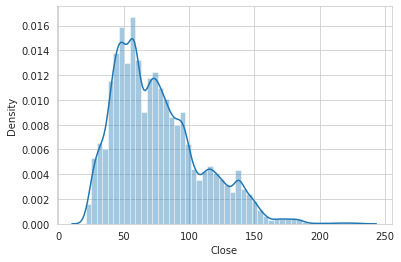
# plot target distribution for a single stock
STOCK_NO = 0
sns.distplot(train.loc[train['stock'] == STOCK_NO, TARGET_COL]).set_title(f'Stock {STOCK_NO}');
/usr/local/lib/python3.7/dist-packages/seaborn/distributions.py:2557: FutureWarning:
`distplot` is a deprecated function and will be removed in a future version. Please adapt your code to use either `displot` (a figure-level function with similar flexibility) or `histplot` (an axes-level function for histograms).
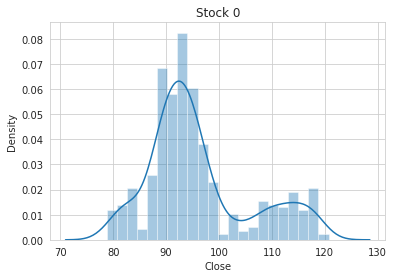
# plot target distribution for a different stock
STOCK_NO = 42
sns.distplot(train.loc[train['stock'] == STOCK_NO, TARGET_COL]).set_title(f'Stock {STOCK_NO}');
/usr/local/lib/python3.7/dist-packages/seaborn/distributions.py:2557: FutureWarning:
`distplot` is a deprecated function and will be removed in a future version. Please adapt your code to use either `displot` (a figure-level function with similar flexibility) or `histplot` (an axes-level function for histograms).
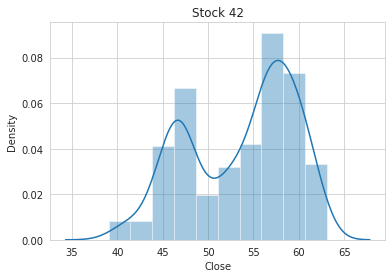
# unique values in each variable
train.nunique()
ID 73439
stock 103
Date 713
Open 60702
High 60594
Low 61015
Close 60352
holiday 2
unpredictability_score 10
dtype: int64
test.nunique()
ID 4223
stock 103
Date 41
holiday 2
unpredictability_score 10
dtype: int64
# explore holiday variable
print(train['holiday'].value_counts())
sns.boxplot(x = train['holiday'], y = train[TARGET_COL]);
0 69216
1 4223
Name: holiday, dtype: int64
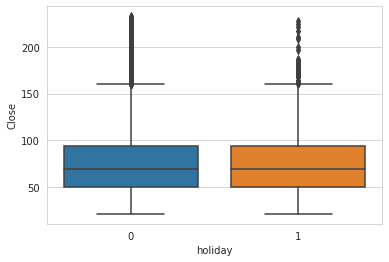
# explore unpredictability_score
print(train['unpredictability_score'].value_counts())
sns.boxplot(x = train['unpredictability_score'], y = train[TARGET_COL]);
9 7843
4 7843
0 7843
8 7130
7 7130
6 7130
5 7130
3 7130
2 7130
1 7130
Name: unpredictability_score, dtype: int64
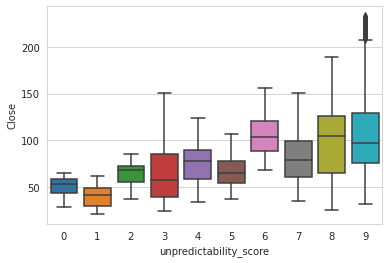
# date ranges
print(train['Date'].min(), train['Date'].max())
print(test['Date'].min(), test['Date'].max())
2017-01-03 00:00:00 2019-10-31 00:00:00
2019-11-01 00:00:00 2019-12-31 00:00:00
# plot holidays in train
train.set_index('Date')[['holiday']].plot(figsize=(16, 4));

# plot Close
train.set_index('Date')[[TARGET_COL]].plot(figsize=(16, 4));

# plot Close for a single stock
STOCK_NO = 0
train.loc[train['stock'] == STOCK_NO].set_index('Date')[[TARGET_COL]].plot(figsize=(16, 4), title = f'Stock {STOCK_NO}');

# plot Close for a different stock
STOCK_NO = 42
train.loc[train['stock'] == STOCK_NO].set_index('Date')[[TARGET_COL]].plot(figsize=(16, 4), title = f'Stock {STOCK_NO}');

Observations
No null values in these datasets. Training dates are from January 2017 to Halloween 2019, test dates are November and December 2019.
We should predict future stock price for 104 different stocks based only on Date, holiday flag (1/0) and an unpredictability_score (1-9).
Closing amount does not seem to differ too much on holidays compared to normal days. Volatility definitely rises with increasing unpredictability_score, as expected. Counts in each score are quite balanced, with 9, 4, and 0 being slightly more common - worth more exploration in the future.
Baseline FB Prophet model!
Let’s define a parallelised Prophet prediction pipeline to speed up the prediction for 104 stocks separately.
Credit for this idea goes to this kaggle kernel.
# Forecast function:
def ProphetFC(stock_no: int):
'''
Predict test prices for each stock separately.
:param stock_no: Stock ID to predict
:returns: Forecasted future dataframe, as return by prophet's .predict method
'''
# Create Prophet model
m = Prophet()
# Create df, add features and fit
tsdf = pd.DataFrame({
'ds': train.loc[train['stock'] == stock_no, 'Date'].reset_index(drop=True),
'y': train.loc[train['stock'] == stock_no, TARGET_COL].reset_index(drop=True),
})
tsdf['holiday'] = train.loc[train['stock'] == stock_no, 'holiday'].reset_index(drop=True)
tsdf['unpredictability_score'] = train.loc[train['stock'] == stock_no, 'unpredictability_score'].reset_index(drop=True)
m.add_regressor('holiday')
m.add_regressor('unpredictability_score')
m.fit(tsdf)
# create future df and predict
future = pd.DataFrame({
'ds': test.loc[test['stock'] == stock_no, 'Date'].reset_index(drop=True),
})
future['holiday'] = test.loc[test['stock'] == stock_no, 'holiday'].reset_index(drop=True)
future['unpredictability_score'] = test.loc[test['stock'] == stock_no, 'unpredictability_score'].reset_index(drop=True)
fcst = m.predict(future)
fcst[ID_COL] = test.loc[test['stock'] == stock_no, ID_COL]
fcst['stock'] = stock_no
return fcst
%%time
# how many stocks to predict for
NUM_STOCKS = train['stock'].nunique()
# parallel jobs to forecast
num_cores = multiprocessing.cpu_count()
processed_FC = Parallel(n_jobs=num_cores)(delayed(ProphetFC)(i) for i in range(NUM_STOCKS))
CPU times: user 3 s, sys: 160 ms, total: 3.16 s
Wall time: 5min 15s
# combining obtained dataframes
FCAST = pd.concat(processed_FC, ignore_index=True)
FCAST.head()
| ds | trend | yhat_lower | yhat_upper | trend_lower | trend_upper | additive_terms | additive_terms_lower | additive_terms_upper | extra_regressors_additive | extra_regressors_additive_lower | extra_regressors_additive_upper | holiday | holiday_lower | holiday_upper | unpredictability_score | unpredictability_score_lower | unpredictability_score_upper | weekly | weekly_lower | weekly_upper | yearly | yearly_lower | yearly_upper | multiplicative_terms | multiplicative_terms_lower | multiplicative_terms_upper | yhat | ID | stock | |
|---|---|---|---|---|---|---|---|---|---|---|---|---|---|---|---|---|---|---|---|---|---|---|---|---|---|---|---|---|---|---|
| 0 | 2019-11-01 | 123.836651 | 117.992600 | 122.187867 | 123.836651 | 123.836651 | -3.858359 | -3.858359 | -3.858359 | -0.083126 | -0.083126 | -0.083126 | 0.0 | 0.0 | 0.0 | -0.083126 | -0.083126 | -0.083126 | 0.098074 | 0.098074 | 0.098074 | -3.873307 | -3.873307 | -3.873307 | 0.0 | 0.0 | 0.0 | 119.978292 | id_713 | 0 |
| 1 | 2019-11-04 | 124.158461 | 118.541425 | 122.710671 | 124.158461 | 124.158461 | -3.492853 | -3.492853 | -3.492853 | -0.083126 | -0.083126 | -0.083126 | 0.0 | 0.0 | 0.0 | -0.083126 | -0.083126 | -0.083126 | -0.073551 | -0.073551 | -0.073551 | -3.336177 | -3.336177 | -3.336177 | 0.0 | 0.0 | 0.0 | 120.665608 | id_714 | 0 |
| 2 | 2019-11-05 | 124.265731 | 118.865930 | 123.259751 | 124.265731 | 124.265731 | -3.231049 | -3.231049 | -3.231049 | -0.083126 | -0.083126 | -0.083126 | 0.0 | 0.0 | 0.0 | -0.083126 | -0.083126 | -0.083126 | -0.007098 | -0.007098 | -0.007098 | -3.140825 | -3.140825 | -3.140825 | 0.0 | 0.0 | 0.0 | 121.034682 | id_715 | 0 |
| 3 | 2019-11-06 | 124.373002 | 119.118231 | 123.431604 | 124.373002 | 124.373002 | -3.067293 | -3.067293 | -3.067293 | -0.083126 | -0.083126 | -0.083126 | 0.0 | 0.0 | 0.0 | -0.083126 | -0.083126 | -0.083126 | -0.045587 | -0.045587 | -0.045587 | -2.938580 | -2.938580 | -2.938580 | 0.0 | 0.0 | 0.0 | 121.305709 | id_716 | 0 |
| 4 | 2019-11-07 | 124.480272 | 119.611473 | 123.998805 | 124.480272 | 124.480272 | -2.787002 | -2.787002 | -2.787002 | -0.083126 | -0.083126 | -0.083126 | 0.0 | 0.0 | 0.0 | -0.083126 | -0.083126 | -0.083126 | 0.026466 | 0.026466 | 0.026466 | -2.730342 | -2.730342 | -2.730342 | 0.0 | 0.0 | 0.0 | 121.693270 | id_717 | 0 |
# define function to plot predictions
def plot_preds(stock_no: int):
'''
PLot Closes for a certain stock separately.
:param stock_no: Stock ID to plot
:returns: nothing
'''
# create temp train df
train_tmp = train.loc[train['stock'] == stock_no].set_index('Date')[[TARGET_COL]]
train_tmp['type'] = 'train'
# create temp test df
test_tmp = FCAST.loc[FCAST['stock'] == stock_no].rename(columns={"yhat": TARGET_COL, 'ds': 'Date'}).set_index('Date')[[TARGET_COL]]
test_tmp['type'] = 'test'
train_tmp.append(test_tmp).groupby('type')[TARGET_COL].plot(figsize=(16, 4), title = f'Stock {stock_no}', sharex=False, legend=True);
pass
# plot stock 0 with preds
plot_preds(0)

# plot stock 42 with preds
plot_preds(42)

# plot stock 100 with preds
plot_preds(100)

Observations
Clearly some of these predictions do not start where the train set ends, so further iterations are needed (perhaps targeted on holidays, seasonality, and its fourier order) to fix this problem.
# submission
submission = FCAST[['ID', 'yhat']].rename(columns={'yhat': TARGET_COL})
submission.to_csv('submission_prophet_baseline.csv',index=False)
# and we're done!
'Done!'
'Done!'